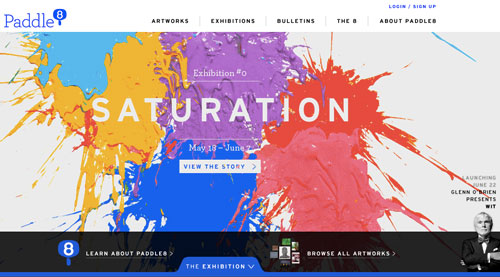Our lives are no longer experienced through the physical constructs of the real world, but, increasingly, our existence, both personally and professionally, is defined by the digital parameters of the world wide web.
While it is still possible to distance yourself from the internet, to live, as it were, in a more traditional sense, as the twenty first century continues to progress, it is going to become increasingly difficult to not only realise your full potential but to enjoy all the benefits that come with technology.
Every facet of society has been transformed by the digital revolution and, over the last few years in particular, the art world has found itself being transformed by this new radicalism. Long-held ideas about the establishment are no longer secure, as is demonstrated by the evolution of online art collecting.
Paddle8 is one example of the innovators in this new and exciting field. The online auction house has only been around since 2011, yet, in just over two years has gone from being a niche business to a powerful entity that is reshaping the conventional narrative of buying art.
Last year the company, which was founded by Alexander Gilkes and Aditya Julka, announced that it had secured $6 million (approximately £3.7 million) worth of funding. This, in itself, from a purely financial vantage point, is of course substantial, but moreover, the list of donors is telling about how important a deal this was.
It included the enfant terrible of art Damien Hirst, owner of White Cube gallery Jay Jopling, Prince Alexander von Furstenberg, the American entrepreneur and privateequity investor Mathew Mellon and the Russian tycoon Vladimir Yevtushenkov.
Another similar and leading venture promoting art in a new way include Artsy, whose founder Carter Cleveland, a computer science graduate from Princeton and from a background of art, told Forbes that he aspires to make his enterprise the “Amazon of the art world”.
Its mission is to make “all the world’s art accessible to anyone with an internet connection” and, as with Paddle 8, is supported by a roster of significant investors. Names include Google’s executive chairman Eric Schmidt, entrepreneur and fashion designer Dasha Zhukova and PayPal co-founder Peter Thiel.
Finishing this small coterie of pioneering online organisations is Artspace. Its philosophy is similar to that of Paddle8 And Artsy, which is “to make it easy for you to discover and collect fine art from renowned artists, galleries, and cultural institutions worldwide”.
It has previously been described by the Wall Street Journal as a venue that provides a “more populist approach to collecting” works of art, principally through expert leverage of galleries, museums and foundations.
“All three sites are attempting to democratize a more than 200-year-old industry whose secretive mores and nuanced relationships have made it opaque to outsiders,” explained the publication’s arts and entertainment writer Ellen Gamerman recently.
“They offer a curated selection of art, art advisory services and tools to discover new work, drawing not just established collectors but neophytes who have felt excluded from the market.”
Naturally, those currently more inclined to buy works of art online are of a younger generation, which is expected given that they have had a more hands on experience with the internet, however, as mentioned from the outset, a lack of engagement with the web will ultimately hinder your ability to flourish (as an artist, a gallery, collector or investor).
Of course, collecting or purchasing art in a digital world isn’t a direct competitor to traditional means. It complements it and builds on historic conventions. It can arguably be considered as the democratisation of art, and certainly, it is opening up the market to newer audiences, to individuals who are priced out nine times out of ten.
This highlights how technology can be brilliantly executed to deliver new possibilities and open up the world of art to millions of people – billions one day perhaps – which is vitally important to for cultural enrichment.
The great thing is that this is still early days for art and the online world. There are plenty of exciting days ahead.
For more information on fine art removal services and storage solutions, click here.
